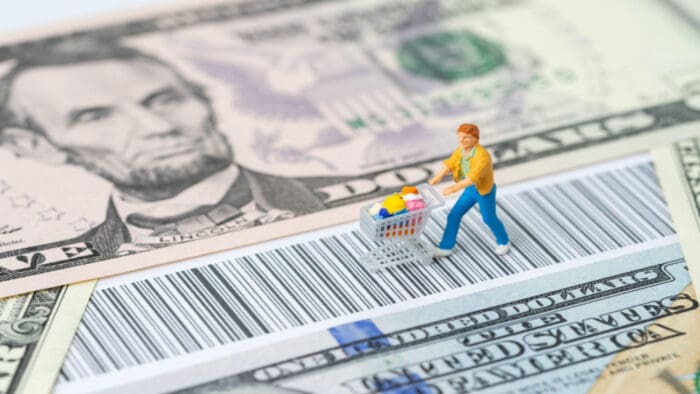Pricing power has become increasingly important for businesses with investors selling off many companies that have been unable to increase revenues and earnings. In contrast, companies that have been successful with passing higher costs on to customers via higher prices have generally been rewarded. This pattern has been intensified by volatile interest rates and lofty valuations amidst late-cycle monetary policy tightening.
A Rock and a Hard Place
In attempting to achieve their ultimate goal, that is delivering profit growth to shareholders, many businesses have been stuck between a proverbial rock and a hard place. Input costs, such as labor, services, product components, energy, and raw materials have increased significantly, generating wide disparities between companies that are able to maintain their margins by increasing selling prices while others resort to discounting, which results in margin compression. Additionally, many are challenged by elevated interest rates both on the revenue and expense side. Higher costs of credit are propelling interest expenses while customers have a more difficult time financing goods and services, pressuring sales. In many instances, customers have balked at higher prices and interest costs.
Despite surprisingly strong household spending in recent months, consumers are likely to tighten their purses and pocketbooks in the next few quarters. Consumer confidence and sentiment collectively point to caution ahead, as depleted pandemic era savings coincide with the resumption in student loan payments. Additionally, many households are struggling with higher living costs, steep interest rates, reduced credit availability and declining bargaining power at job interviews. These challenges are occurring as the personal savings rate declines, pressuring spending capacity.
Stretched Valuations Increase Importance of Pricing Power
As of last Friday, the S&P 500 Index had a 12-month forward P/E ratio of 17.8 compared to the 10-year average of 17.5, according to FactSet. But when comparing valuations to the current level of interest rates, shares are priced expensively, as today’s 10-year Treasury yield hovers around 4.6% while its 10-year average is roughly 2.3%. When considering the risk premium, or the benefit of taking risk against the backdrop of the current risk-free rate, it’s 10-year average of 3.4% trounces today’s 1%. Results are even more stark when calculating the risk-free rate with shorter-term bond yields.
While during some time periods, investors are drawn to equities because stock valuations have been driven down and are therefore attractive, investors in recent months have focused on the potential for earnings growth, which if achieved, may justify current valuations. The ability to grow earnings has also become increasingly risky as investors fear that a recession is possible in 2024.
FactSet notes that companies with positive third-quarter earnings surprises experienced an average stock price increase of 0.8% from the period starting two days before reporting results until two days after the earnings release. This increase is slightly below the five-year average price increase of 0.9% for companies that have reported positive earnings surprises.
A more dramatic variation from the historical average exists for companies that missed earnings expectations. Negative earnings surprises for the third quarter sparked, on average, a 5.2% price decrease, according to FactSet. During the past five years, the average decline among companies with negative earnings surprises was only 2.3%. The 5.2% average decline in the third quarter was the largest since the second quarter of 2011 when declines averaged 8%.
Challenging Environment To Hike Prices
Throughout the third quarter, companies cited a variety of headwinds to increasing their selling prices. These headwinds include competition, weaker demand and convenience for customers to choose lower cost options.
Competition is a strong obstacle for companies seeking to increase their prices. This is illustrated in the electric vehicle Industry. Initially, Tesla benefited from being among the first companies to produce EVs and it has generated impressive growth. More recently, however, significant U.S. tax incentives, higher fuel costs, and growing concerns about climate change have lured traditional automotive companies into the EV market. China is also aggressively building lower cost EVs as it seeks to capture market share. In this environment, EV manufacturers seeking to improve their competitiveness have had to cut costs, which has hurt earnings.
In this challenging environment, Tesla’s price discounting weighed heavily on its third-quarter results. In a statement describing price pressures, Tesla CEO Elon Musk emphasized that the size of monthly car loan payments has become a critical factor for consumers. Since announcing its third-quarter results, Tesla’s share price has declined approximately 10%.
A.P. Moller Maersk also reported disappointing third-quarter results that were challenged by competition and a market in which shipping fees have declined dramatically. Maersk said the pandemic driven boom in cargo has ended, resulting in a surplus of vessels and a steep decline in shipping rates and profits. In early October, the Wall Street Journal reported that rates for ocean freight haulers have declined 90% from early 2022. Maersk plans to lay off 10,000 workers, which will save $600 million in 2024. The company’s share price dropped approximately 20% in the hours immediately following its earnings announcement.
In another example, Apple’s revenues in the fiscal fourth quarter ended September 30 dropped 1% year-over-year (y/y) to $89.48 billion. Despite revenues for services increasing y/y from $19.18 billion to $22.31 billion, device sales dropped from $70.95 billion to $67.18 billion, causing the third quarter to become the fourth consecutive quarter of weakening sales. Apple also believes the trend of declining revenues may potentially continue in the current quarter. Meanwhile, the company’s share price is approximately 10% below its all-time high that was established in July.
The availability for consumers to choose lower cost options has also resulted in certain companies struggling during recent months. Darden Restaurants, for example, faced the headwind of customers selecting lower cost menu items and cutting back on buying alcoholic drinks. Its fine dining segment saw a decline in visits to locations among consumers with incomes above $125,000. The availability of lower-cost menu items and the decline in visits resulted in the company’s same-store sales declining y/y.
Camping World Holdings also demonstrated the dire consequences of lacking pricing power. Its third-quarter revenue fell 6.8% y/y to $1.7 billion and its gross profits fell 11.9%, or $70.6 million, to $523 million. For the quarter, its average selling price for new and used vehicles dropped 5.7% and 5.2%, respectively, and the company’s unit sales volume declined. Camping World steeply discounted older models of campers to clear inventory in response to procurement prices for 2024 models of campers declining relative to campers in 2022 and 2023.
Certain companies also face competition from low-price generic products or even illicit products. Altria Group, which owns Philip Morris, experienced a third-quarter y/y decline in revenues due to an overall drop in tobacco consumption but also because of competition from lower-cost illicit e-vapor products. The two trends caused the company’s third-quarter revenue of $6.28 billion to fall short of revenue in the year-ago quarter by 4.1%. The price of Altria shares promptly declined approximately 10% after the company’s earnings announcement.
Newell Brands, which makes Sharpie pens, Rubbermaid products, Coleman camping gear and other popular branded items, saw its sales decline after it ushered in a roughly 10% price increase this spring for one third of its products. Consumers are likely to have switched to lower cost options or to have simply decided to hold off on discretionary purchases with the company’s outdoor and recreation segment experiencing a 20.9% y/y sales decline. Newell Brands also provided disappointing earnings guidance for the current quarter, causing its share price to sink to a 14-year low. Newell generated a loss of $218 million, or $0.53 a share compared to a profit of $19 million, or $0.50 a share in the year-ago quarter. The company said it has been experiencing weakening demand while its input costs continue to rise.
Success Comes with Caution
Various companies have developed innovative products to capture market share and in other instances, brand loyalty has helped companies maintain sales revenues even after they have increased their prices. In other examples, certain companies have benefited from a tailwind of growing demand.
Whirlpool has avoided discounting its prices and it has increased its market share with innovations such as dryers with filters that remove pet hair and dishwashers with three racks. For the third quarter, Whirlpool’s net sales of $4.93 billion beat the analyst consensus forecast of $4.81 billion and climbed 3.6% y/y. Whirlpool is expecting to resort to discounting in future quarters, however, as it trimmed its earnings guidance in response to an outlook of slower consumer spending.
Brand strength has also helped certain companies succeed with price increases, even if higher prices caused unit volume sales to decline. Proctor & Gamble, which makes Tide laundry detergent, Charmin toilet paper and other household products, said that certain customers have turned to lower cost private-labeled products in response to the company increasing its prices. Despite its sales unit volume declining for the sixth-consecutive quarter, its higher prices resulted in its revenues increasing 6% y/y. Its share price has been somewhat flat, largely due to the company lowering its revenue to the bottom of its previous guidance range of 3% to 4% for fiscal-year 2024 because of the anemic Chinese economy and consumers cutting back on spending.
Companies in industries that are growing strongly have also been successful with increasing their prices. Norwegian Cruise Lines has enjoyed the tailwind of growing demand for cruises even as it has increased prices. For the third quarter, Norwegian Cruise Lines generated revenue of $2.54 billion, which increased from $1.6 billion in the year-ago quarter. Onboard purchases and other sales accounted for $300 million of the y/y increase. It generated $345.9 million in profits, up from a $295 million loss in the third quarter of last year. Its stock price has been somewhat flat, however, because it expects challenges to its future earnings due to higher fuel costs, the Hamas-Israel conflict and unfavorable currency exchange rates.
The Appeal of Active Management Grows
Third-quarter results illustrate how challenging economic conditions can increase the disparity of equity performance among companies that have strong pricing power and those without. Strong economic growth is much like a rising tide that lifts all boats. During such conditions, the equity performance of companies may be highly correlated because companies can generally grow earnings handily. In such an environment, index investing may be appealing because the lack of divergence in equity performance may make it difficult to pick companies that will outperform the overall market.
When waters become turbulent due to economic challenges, mediocre companies may not be able to maintain pricing and earnings. In this environment, active management is more appropriate because high-quality stock pickers can find companies that can grow earnings and outperform. Additionally, during times of uncertainty, hedging investments with options is another appealing aspect of active management. Skilled options traders can outperform in an up, down, or flat market.
Visit Traders’ Academy to Learn More About Corporate Earnings and Other Economic Indicators.
Disclosure: Interactive Brokers Affiliate
Information posted on IBKR Campus that is provided by third-parties does NOT constitute a recommendation that you should contract for the services of that third party. Third-party participants who contribute to IBKR Campus are independent of Interactive Brokers and Interactive Brokers does not make any representations or warranties concerning the services offered, their past or future performance, or the accuracy of the information provided by the third party. Past performance is no guarantee of future results.
This material is from IBKR Macroeconomics, an affiliate of Interactive Brokers LLC, and is being posted with its permission. The views expressed in this material are solely those of the author and/or IBKR Macroeconomics and Interactive Brokers is not endorsing or recommending any investment or trading discussed in the material. This material is not and should not be construed as an offer to buy or sell any security. It should not be construed as research or investment advice or a recommendation to buy, sell or hold any security or commodity. This material does not and is not intended to take into account the particular financial conditions, investment objectives or requirements of individual customers. Before acting on this material, you should consider whether it is suitable for your particular circumstances and, as necessary, seek professional advice.





















Join The Conversation
For specific platform feedback and suggestions, please submit it directly to our team using these instructions.
If you have an account-specific question or concern, please reach out to Client Services.
We encourage you to look through our FAQs before posting. Your question may already be covered!